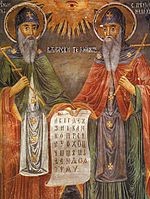Saints Cyril and Methodius facts for kids
Quick facts for kids Saints Cyril and Methodius |
|
|---|---|

"Saints Cyril and Methodius holding the Cyrillic alphabet," a mural by Bulgarian iconographer Z. Zograf, 1848, Troyan Monastery
|
|
| Bishops and Confessors; Equals to the Apostles; Patrons of Europe; Apostles to the Slavs | |
| Born | 826 or 827 and 815 Thessalonica, Byzantine Empire (present-day Greece) |
| Died | 14 February 869 and 6 April 885 Rome and Velehrad, Moravia |
| Venerated in | Catholic Church Eastern Orthodox Church Anglican Communion Lutheranism |
| Feast | 11 and 24 May (Orthodox Church) 14 February (present Roman Catholic calendar); 5 July (Roman Catholic calendar 1880–1886); 7 July (Roman Catholic calendar 1887–1969) 5 July (Roman Catholic Czech Republic and Slovakia) |
| Attributes | brothers depicted together; Eastern bishops holding up a church; Eastern bishops holding an icon of the Last Judgment. Often, Cyril is depicted wearing a monastic habit and Methodius vested as a bishop with omophorion. |
| Patronage | Bulgaria, North Macedonia, Czech Republic, Slovakia, Transnistria, Archdiocese of Ljubljana, Europe, Slovak Eparchy of Toronto, Eparchy of Košice |
Saints Cyril and Methodius were two brothers who became important Christian missionaries. They helped spread Christianity to the Slavic people living near the Danube River. Their work greatly shaped the culture and religion of many Slavic groups. Because of this, they are often called the "Apostles to the Slavs".
Contents
Early Lives and Education
The brothers were both born in Thessalonica, a city in the Byzantine Empire. Methodius was born around 815 or 826 and passed away in 885. Cyril was born around 826 and died in 869. He was also known by his adopted name, Constantine.
Cyril received a good education at the University in Constantinople. He studied under a famous scholar named Photios I of Constantinople. Later, Cyril even taught at the university himself. Around the same time, Methodius became a governor in a region called Opsikion.
Their Important Missions
In 861, the Byzantine Emperor Michael III sent Cyril and Methodius on a special mission. They were to travel to the Khazars to help convert them to Christianity. For two years, they continued their religious work with the Tatar people along the Black Sea.
After this, Emperor Michael sent them to Moravia as missionaries. This was a very important journey. They taught people in their own Slavic languages. They also translated parts of the Bible into Slavonic.
Creating an Alphabet
One of Cyril's most important achievements was inventing an alphabet. This alphabet was called the Glagolitic alphabet. It was a brand new way to write down the Slavic languages.
The Glagolitic alphabet later became the basis for the Cyrillic alphabet. Many Slavic languages, like Russian and Bulgarian, still use the Cyrillic alphabet today. The old Slavic language, called Old Church Slavonic, was written using both Glagolitic and Cyrillic scripts.
Images for kids
-
Cyril and Methodius, painting by Jan Matejko, 1885
-
The Baška tablet is an early example of the Glagolitic from Croatia
-
Basilica of St.Cyril and Methodius in Moravian Velehrad, Czech Republic
-
Inauguration of the monument to Saints Cyril and Methodius in Saratov on Slavonic Literature and Culture Day
-
Thessaloniki - monument of the two Saints gift from the Bulgarian Orthodox Church
-
Bulgaria - Statue of the two Saints in front of the SS. Cyril and Methodius National Library in Sofia
-
North Macedonia - The monument in Ohrid
-
North Macedonia - Statue of Cyril and Methodius near the Stone Bridge in Skopje
-
Czech Republic - Statue of Saints Cyril and Methodius at the Charles Bridge in Prague
-
Czech Republic - Saints Cyril and Methodius monument in Mikulčice
-
Czech Republic - Statue of Saint Methodius at the Holy Trinity Column in Olomouc in Moravia
-
Russia - the monument in Khanty-Mansiysk
-
Opening of Cyril and Methodius monument in Donetsk
See also
 In Spanish: Cirilo y Metodio para niños
In Spanish: Cirilo y Metodio para niños























